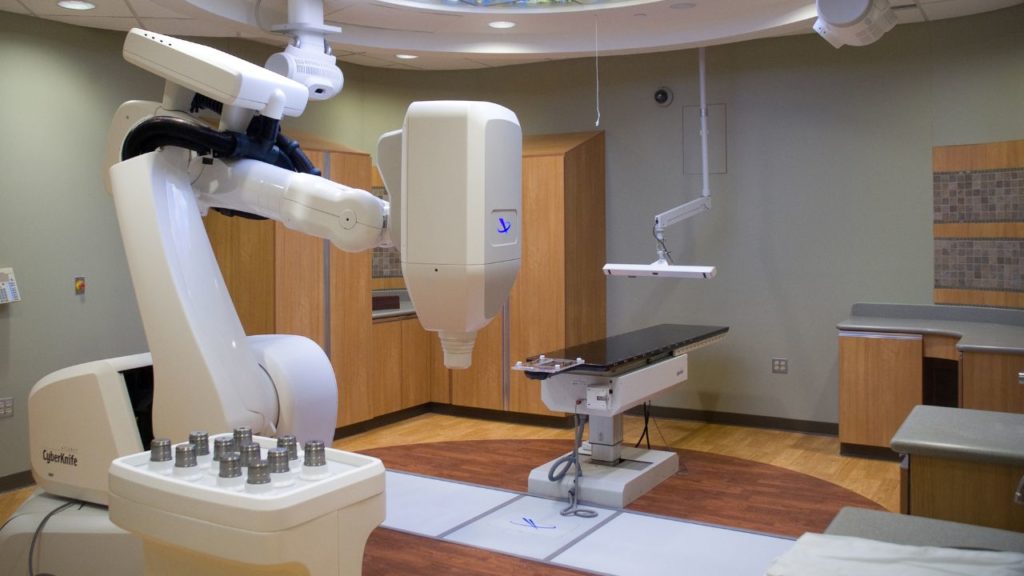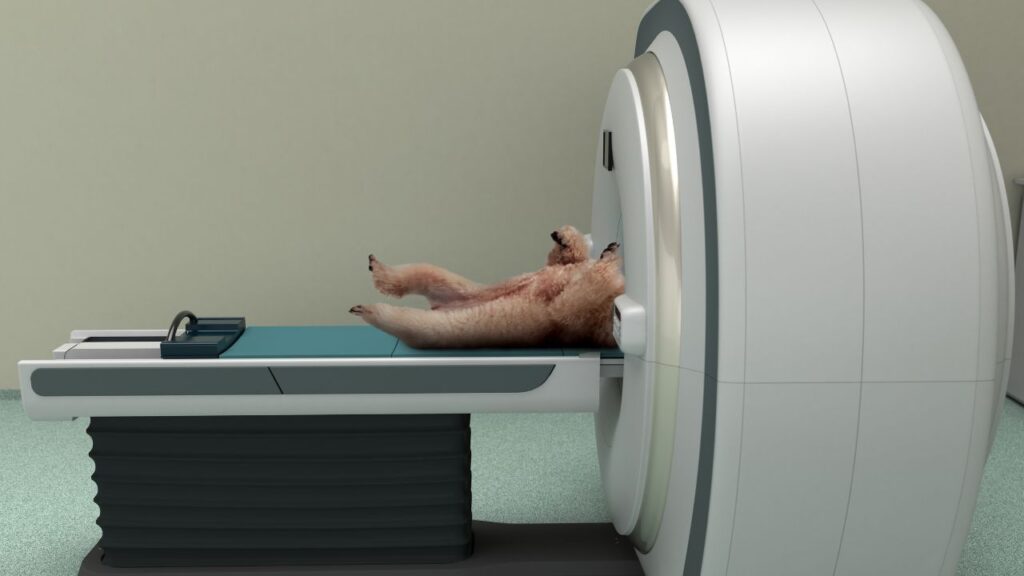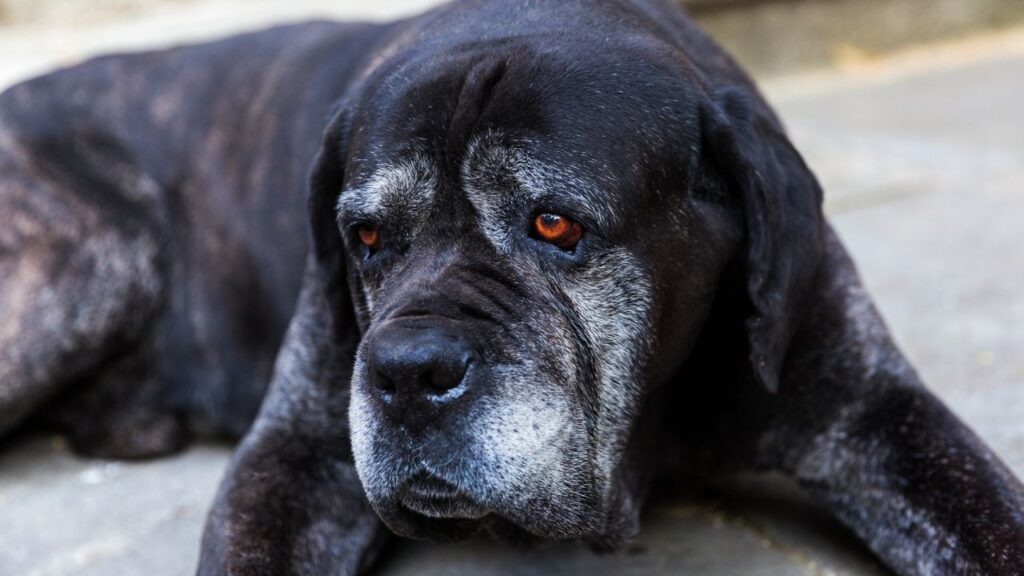Brain tumors are typically benign, growing slowly and only rarely spreading to other areas of the body. However, they grow within the confines of the skull which can cause many serious neurological symptoms. Neurosurgery, radiation therapy, and chemotherapy can slow the progress of or even kill brain tumors.
Key Takeaways
- The symptoms of a dog with a brain tumor vary based on the location and type of tumor. Symptoms seen most often include seizures, stumbling, circling, dragging feet, vision problems, and new or unusual behaviors.
- Most dogs live anywhere from 2 months to 2.5 years, depending on if the tumor can be treated.
- The final stages of brain tumors in dogs usually include a worsening of the symptoms that were seen in the first place.
- Dogs with brain tumors may or may not suffer, depending on if they have uncontrolled seizures, whether the tumor is pressing on the brain, and many other factors.
- A dog can get a brain tumor at any age, including puppies. Most dogs are middle-aged to older, with a median age of 9 years old.
- Brain tumors can make dogs sleepy, but they will usually have other symptoms, too. It is essential to have your veterinarian examine your dog and run some tests any time your dog has a new or unexplained behavior.
Brain Tumor in Dogs: Growing In a Confined Space
Brain tumors in dogs come from the cells surrounding the brain (an extra-axial tumor) or from cells that are inside the brain (intra-axial). Tumors from other parts of the body can also metastasize to the brain.
Brain tumors are classified by the cells they originate from and are further described by their location and activity.
Brain tumors grow in a limited space (the skull), no matter what type of cell they are from.
Types of Brain Tumors in Dogs
There are many types of canine brain tumors. How common they are, what breeds tend to get them, and how they are diagnosed and treated varies widely. It is fairly rare to biopsy brain tumors ahead of full surgery to get a diagnosis, so oncologists rely heavily on MRI characteristics to give a presumptive diagnosis.
Meningioma
Meningiomas — which grow from the meninges tissue surrounding the brain — are the most common brain tumor in dogs. 50% of all primary brain tumors in dogs are meningiomas.
Magnetic Resonance Imaging (MRI) will correctly identify intracranial (inside the skull) meningiomas between 60% and 100% of the time.3
Breeds more likely to have meningiomas include:2
- Golden Retrievers
- Boxers
- Miniature Schnauzers
- Rat Terriers
Glioma
Gliomas – which grow from the glial cells that support the nerve cells inside the brain — are the second most common brain tumor in dogs.3 About 35% of canine brain tumors are gliomas.
There are three types of gliomas in dogs:
- Oligodendrogliomas – 70% of all gliomas
- Astrocytomas – 20% of all gliomas
- Undefined glioma – 10% of all gliomas
Gliomas in dogs are further divided into low grade (slow growing) or high grade (more rapidly growing). High grade gliomas carry a poor prognosis (likely outcome).3
With Magnetic Resonance Imaging (MRI), veterinary oncologists can estimate if your dog’s glioma is high or low grade based on how bright it is on the image (contrast enhancement) and its location in the brain.
Brachycephalic dog breeds are more commonly affected by gliomas.1 This includes breeds such as:
- Boxers
- Boston Terriers
- English Bulldogs
Choroid Plexus Tumors
Choroid plexus tumors – which grow from the choroid plexus cells that make the cerebrospinal fluid that nourishes and protects the brain – are much less common. These brain tumors, often called choroid plexus papillomas, or ependymomas, represent about 7-12% of all primary canine brain tumors.1,2
Choroid plexus tumors can spread by shedding cells into the cerebral spinal fluid, which circulates to other areas of the brain and spinal cord.1
Choroid plexus tumors are more commonly seen in Golden Retrievers.2
Pituitary Tumors
Pituitary tumors – which grow from the pituitary, a tiny but important gland deep inside the base of your dog’s brain — are common in dogs.
The pituitary gland is an important part of the endocrine system, which controls body functions through hormone secretion into the bloodstream. To summarize a very complicated little organ, the pituitary gland plays a key role in many body functions:
- Water and salt balance
- Metabolism (how the body utilizes food energy)
- Growth
- Stress management
- Reproduction, lactation, and whelping (birth)
Many pituitary tumors in dogs remain small (microadenomas) and do not cause neurologic symptoms, but symptoms related to the above endocrine functions may be seen. Pituitary tumors can be functional (secretes pituitary hormones) or non-functional (does not secrete pituitary hormones).
Functional pituitary tumors usually cause a hormone imbalance called pituitary-dependent hyperadrenocorticism, or Cushing’s disease. Cushing’s disease has other causes, but a functional pituitary tumor is the most common cause, affecting about 80% of the dogs with Cushing’s disease.1 Cushing’s disease can be managed with medications.
Though most symptoms seen with pituitary tumors are related to hormone imbalances, large pituitary tumors may cause neurologic symptoms. Some large tumors may not cause problems, but about 50% of dogs with macroadenomas (large tumors) will have neurologic symptoms.1
Primary Skeletal Tumors
Though technically a bone tumor, tumors arising from the skull can also affect the brain. Multilobular osteochondroma (now frequently called multilobular tumor of bone) is a tumor that grows from the bones of the skull, pushing in on the brain to cause symptoms.1
Multilobular osteochondroma / multilobular tumor of bone may be described as high, intermediate, or low grade. The grade of the tumor will influence the likelihood that it will metastasize — or spread to other parts of the body.1
Other Brain Tumors
The remaining 10% of canine brain tumors are rare tumors of embryonic (fetal) origin and metastatic tumors (tumors that have spread to the brain from other areas of the body).2
Other very uncommon primary brain tumor types include:1,2
- Tumors of nerve cells (such as neuroblastoma, ganglioneuroblastoma, and ganglioneuroma)
- Pinealomas
- Glioblastoma
- Craniopharyngiomas (Dobermans may have a predisposition to this tumor)1
- Spongioblastomas (embryonal glioma)
- Histiocytic sarcomas
- Meningioangiomatosis
- Malformation tumors of embryonic origin
- Medulloblastomas
Stats and Facts
- Brain tumors account for 2-3% of all canine cancers.1
- Brachycephalic dogs – dogs with short heads – are more likely to get brain tumors (especially gliomas) compared to other breeds.2 These brachycephalic breeds include French Bulldogs, English Bulldogs, and Boxers.
- Genetic markers have been found in some dog breeds that show an increased likelihood to form tumors.2
- Dogs that develop brain tumors are usually middle-aged to older adults with an average age of nine.3 Brain tumors have been found in dogs less than 6 months old.1
Dr. Demian Dressler explains all about brain tumors in dogs in this Exam Room Series DOG CANCER ANSWERS episode.
Brain Cancer Causes in Dogs
Some factors increase your dog’s risk of developing brain cancer, but there is no known specific direct cause of brain tumors in dogs.2
Risk Factors for Canine Brain Tumors
Multiple dog breeds have genetic markers that show an increased risk of developing brain tumors. Three genes that are highly associated with susceptibility to glioma include DENR, CAMKK2, and P2RX7.2
Brachycephalic dogs are more likely than other breeds to develop brain tumors.
Dog breeds that have an increased risk of developing brain tumors include:1,2
- Golden Retriever
- Boxer
- Miniature Schnauzer
- Rat Terrier
- French Bulldog
- English Bulldog
- Boston Terrier
- Doberman Pinscher
Signs of Brain Tumors in Dogs
Dogs with brain tumors may not have symptoms at all. If symptoms are seen, they are usually neurologic abnormalities.
- One study of 60 dogs with gliomas found that 42% of them had seizures.
- 22% had other signs like incoordination and changes in behavior.
- In the same study, 52% of the dogs had abnormal neurologic examination findings, but 48% were neurologically normal.2, 3
It is important to have diagnostic tests after your dog’s first seizure, even if there are no other neurological symptoms. This is especially true if your dog is over 6 years old.
Other neurological signs of a brain tumor depend on the affected brain area. These symptoms include:
- Stumbling
- Circling
- Dragging the feet
- Vision problems
- New aggression toward family members
- Getting stuck in corners
- Pacing
- Changes in the sleep/wake cycle
- Any new and abnormal behavior
Is Brain Cancer in Dogs Painful?
Brain cancer may or may not be painful, depending on the size of the tumor and how it is pressing on the skull and brain. End-stage cancer is more likely to be painful.
Your veterinarian will have pain assessment and management in mind as they treat your dog with brain cancer.
Report Neurological Changes and Seizures Quickly
Your dog’s neurological or behavioral changes should be reported to your veterinarian. Most symptoms can wait for a regular appointment, but if your dog has a seizure, he should be evaluated by a veterinarian as soon as possible. If a seizure lasts one minute or longer, you should seek emergency care for your dog.
How Veterinarians Diagnose Brain Tumors in Dogs
Your veterinarian will do a thorough neurological and physical examination and consider tests such as:
- Full blood chemistries
- Complete Blood Count (CBC)
- Thyroid levels
- Thoracic radiographs (x-rays)
- Abdominal ultrasound
These diagnostics will provide a baseline of your pet’s general health and look for extracranial causes (reasons that didn’t start inside the brain, such as toxins or metabolic diseases) for the seizure.
Based on these findings, your veterinarian may recommend imaging of the head, particularly the brain. MRI is the best imaging modality for the brain. Depending on the availability of MRI, your veterinarian may recommend a CT instead.3
A normal MRI does not always rule out a brain tumor.3 Your veterinarian may also recommend checking a CSF (cerebral spinal fluid) sample. This procedure is performed under anesthesia and is painless for your dog.
Researchers are currently looking for canine cancer biomarkers in cerebrospinal fluid (CSF). This may be helpful when surgery or biopsy is not an option. It also allows veterinarians to further analyze the information seen on MRI or CT.3
Your dog’s veterinary team can make a treatment plan based on imaging and test results.
Staging and Prognosis for Brain Tumors
Staging means finding how much cancer is in your dog’s body and where it has spread. It is important to your dog’s cancer therapy and long-term care. For example, unrelated cancers in the chest and abdomen have been identified in anywhere from 3-23% of dogs with primary brain tumors,3 and finding those cancers before starting treatment will help you make more confident decisions.
Staging is also helpful to get a complete picture of your dog’s health.
Staging tests include:
- Full laboratory blood testing
- Thoracic radiographs
- Abdominal ultrasound
- Advanced imaging (MRI or CT)
- Histopathology (biopsy) if possible
Once your dog’s tumor has been staged, your veterinarian will be able to predict the probable outcome or prognosis.
It is hard to predict how long a dog will live with a brain tumor since more studies need to be done. The infrequency of brain tumors compared to other forms of canine cancer leads to small study sizes, making survival time predictions very difficult.
The type and location of the mass, the patient’s condition, and the surgeon’s skill in performing surgery are among a few of the other variables we do not know much about.3
We do have a few studies we can look at. Meningioma treated with surgery alone results in a mean survival time of 10 months. Meningioma treated with surgery and radiation increased mean survival time to 16–30 months (about 2 and a half years).3
Gliomas and choroid plexus tumors have a worse prognosis. Because of their location and invasion into surrounding tissue, these types of tumors are less likely to be treated with surgery alone. Mean survival time after surgery alone for these tumors is 2 months.3 Dogs with gliomas that have had surgery and either chemotherapy or immunotherapy have an estimated survival time of six months.
Brain Cancer in Dogs: Treatment
Cancer treatment in dogs is not usually about getting a “cure.” Instead, the focus is on improving and maintaining the quality of life while hopefully extending the dog’s life beyond what would happen if the cancer wasn’t treated.
For dogs with brain cancer, radiation therapy is often an important part of treatment.
Radiation
Radiation may be used alone or in conjunction with surgery. It is an excellent option for many brain cancer patients, especially those that can’t have surgery.
The success of treating canine brain tumors with radiation varies widely. Some studies suggest radiation therapy alone may provide a 7-to-24-month (about 2 years) survival time.3
The location of the brain tumor can affect whether or not radiation treatment is successful. Extra-axial (on the outside of the brain) tumors appear more responsive to radiation than intra-axial (on the inside of the brain) tumors.
Overall, the rate of treatment-related complications or death in dogs who had radiation therapy is 10%.2
Stereotactic radiation therapy (SRT) is an option for brain tumors and may offer some advantages.10 This specialized type of radiation is more precise, allowing the veterinary radiation oncologist to give a higher dose. Only one to three treatments are needed, so your dog is under anesthesia for less time. Cyberknife is a specific brand of machine that delivers Stereotactic radiation therapy (SRT).
Radiation specialist Jenny Fisher explains all about radiation for dogs in this incredible DOG CANCER ANSWERS episode.
Surgery
Surgery can be an option for some dogs with brain tumors, though how much the surgeon can take varies widely. Your dog will need a specialist neurosurgeon to have brain surgery or a brain tumor biopsy.
A surgical biopsy (taking a sample) of your dog’s brain tumor can help in diagnosis and may be an option, especially when it is not possible to remove the entire tumor. Canine brain tumor biopsies have a 95% chance of getting a helpful sample, with serious complications less than 5% of the time.3 Some brain tumors are in locations that make them impossible to biopsy.
In other cases, it is possible to remove part or all of the brain tumor. The frequency of serious complications associated with brain surgery has been reported as anywhere from 6% to 100 %.3
Some types of canine brain tumors do relatively well with surgical removal, especially meningiomas or multilobular osteochondromas that grow more on the brain’s surface.3
The outcomes associated with the complete surgical removal of canine meningiomas vary widely. Factors that affect the success of your dog’s brain tumor surgery include the surgeon’s skill and other technical factors in addition to the tumor’s grade, size, shape, and invasiveness.3
Chemotherapy
Your dog’s body has built-in mechanisms to protect the brain and spinal cord from infections and other threats that enter the bloodstream. This is called the blood-brain barrier (BBB). Many medications cannot cross the BBB, meaning that they will not be able to reach a tumor in the brain.
There are a few chemotherapeutic drugs that can cross the blood-brain barrier. The ones most commonly used for brain tumors include:1,3
- Lomustine (CCNU)
- Carmustine (BCNU)
- Temozolomide (TMZ)
There have also been some suggestions that using COX-2 inhibitors (nonsteroidal anti-inflammatories) may limit meningioma growth.3
Immunotherapy
Numerous immunotherapy (IT) strategies are currently being studied to treat canine brain tumors. The goal is to use the patient’s own immune system (T-cell mediated) against cancer cells.2 Immunotherapy treatments that use vaccinations have shown good safety and practicality, and are potentially helpful against canine glioma and meningioma.2
Vaccine
There is currently no vaccine for any brain tumors in dogs. They are being investigated as part of immunotherapy treatments (see above).2
Palliative Therapy
Palliative therapy is geared towards making the patient comfortable and maintaining a good quality of life for as long as possible. Anticonvulsants, corticosteroids (to manage swelling around the tumor), and pain medications are commonly used drugs.2
Dogs treated with hospice or palliative care for the brain tumors often have a poor prognosis, but this can vary significantly based on where the cancer is in the brain. One study found that tumors in the upper portion of the brain had better survival times.13
One study found that 6% of meningiomas in dogs were incidentally found (discovered by chance) on MRI. These dogs did not have symptoms. Because of this, some specialists may argue for monitoring with repeat MRI’s and palliative therapy as a long-term treatment plan.2
Ongoing Research
There are several kinds of promising treatment options for canine brain tumors that are currently being studied but are not widely available yet:2
- Macroscopic tumor targeting techniques
- Stereotactic tumor tissue ablation
- Direct CNS drug delivery
Diet
While there are no specific diet recommendations for dogs with brain cancer, ketogenic diets have been explored for brain tumors in humans and mice and for dogs with epilepsy.
Early studies (mostly in mice and a few human cases) have found that cancerous brain cells depend more on glucose as an energy source than normal brain cells. Feeding a strict ketogenic diet can deprive the cancer cells of nutrients while the normal cells are still able to function. This has not yet been studied in clinical trials in humans or dogs.11
A 2016 study using 21 dogs with epilepsy investigated the effects of feeding a ketogenic diet. 48% of the dogs had no seizures or a 50% reduction in seizure activity while on the diet.4 The diet change did not cause a significant change in phenobarbital or bromide (anticonvulsants) blood levels.4
Purina NeuroCare (R) is an example of a commercially made ketogenic diet that is recommended by most veterinarians. If you would rather cook a homemade ketogenic diet, consult with a veterinary nutritionist for guidance.
Dogs with true idiopathic epilepsy do not have brain tumors, so these results may or may not be helpful for dogs having seizures due to brain cancer.
Supplements
Although there are a variety of herbs used to support patients with cancer or those being treated for cancer, there are no studies looking directly at brain tumor treatment in dogs.
Studies in humans with brain cancer have found benefits from the following supplements:5
- Boswellia
- Cannabis
- Aloe vera in combination with melatonin
- Mistletoe
A variety of supplements have also been suggested to aid in seizure management, including omega 3 fatty acids (EPA and DHA), thiamine (vitamin B1), vitamin E, melatonin, hemp-based cannabidiol (CBD) oil, and Huperzine A.6 These supplements may or may not benefit dogs whose seizures are caused by brain tumors.
Integrative Therapies
Integrative therapies to aid in seizure management in dogs include:
- Acupuncture7
- Acupressure8
- Gold bead therapy9
Chinese herbs can be added to other treatments to help manage brain tumors and seizures in dogs.12
Dr. Katie Woodley's own adventure in holistic medicine started when her beloved Finn was diagnosed with a brain tumor.
What the End Looks Like for Dogs with Brain Cancer
If your dog’s brain tumor grows or recurs after surgery, radiation therapy, or other treatments, the symptoms will depend on the damaged area of the brain. You will likely see very similar signs to what you saw when your dog was first diagnosed.
Seizures, coordination issues, and cognitive issues are some of the more common observations.2,3 Symptoms will continue to get worse as the tumor grows. As your dog’s quality-of-life declines, you should consider hospice care and euthanasia.
Prevention Strategies for Brain Cancer
There are no known prevention strategies for brain cancer in dogs, but in general, you can lower the risk of cancer developing with a high-quality diet, plenty of exercise, and lifestyle changes.
- Smith AN. Neoplasia of the Nervous System in Animals. Merck Manual Veterinary Manual, medically reviewed Jun 2020. modified nov 2022. https://www.merckvetmanual.com/nervous-system/neoplasia-of-the-nervous-system/neoplasia-of-the-nervous-system-in-animals?query=Brain%20tumors
- Miller AD, Miller CR and Rossmeisl JH. Canine Primary Intracranial Cancer: A Clinicopathologic and Comparative Review of Glioma, Meningioma, and Choroid Plexus Tumors. Front. Oncol. 2019:9:1151. doi: 10.3389/fonc.2019.01151
- Pons-Sorolla M. Dominguez E.;Czopowicz M. Suñol A. Maeso Ordás, C. Clinical and Magnetic Resonance Imaging (MRI) Features, Tumour Localisation, and Survival of Dogs with Presumptive Brain Gliomas. Vet. Sci. 2022, 9, 257. https://doi.org/10.3390/ vetsci9060257
- Karon A, Ketogenic Diet Linked to Seizure Reduction in Dogs with Epilepsy, July15,2016, https://www.dvm360.com/view/ketogenic-diet-linked-to-seizure-reduction-in-dogs-with-epilepsy.
- Wynn SG and Fougere BJ. Veterinary Clinical Uses of Medicinal Plants. Veterinary Herbal Medicine A Systems Based Approach. Elsevier, 2007; p302
- Koh R. Improve Seizure Control with Integrative Medicine. World Small Animal Veterinary Association Proceedings; 2018. https://www.vin.com/apputil/content/defaultadv1.aspx?pId=22915&id=8896846
- Klide AM, Farnbach GC, Gallagher SM. Acupuncture therapy for the treatment of intractable, idiopathic epilepsy in five dogs. Acupunct Electrother Res. 1987;12(1):71-4. doi: 10.3727/036012987816358931. PMID: 2883839.
- Snow A. Accupressure to Reduce Seizures in Dogs; Animal Wellness Magazine, 2014. https://animalwellnessmagazine.com/acupressure-for-seizures-dogs/
- Durkes TE. Gold bead implants. Probl Vet Med. 1992 Mar;4(1):207-11. PMID: 1581658.
- Kelsey KL, Gieger TL, Nolan MW. Single fraction stereotactic radiation therapy (stereotactic radiosurgery) is a feasible method for treating intracranial meningiomas in dogs. Veterinary Radiology & Ultrasound. 2018;59(5):632-638. doi:10.1111/vru.12636
- Seyfried TN, Kiebish MA, Marsh J, Shelton LM, Huysentruyt LC, Mukherjee P. Metabolic management of Brain Cancer. Biochimica et biophysica acta. https://pubmed.ncbi.nlm.nih.gov/20804725/. Published September 8, 2010. Accessed February 12, 2023.
- Chen JK, Chen TT, Beebe S, Salewski M. Chinese Herbal Formulas for Veterinarians. City of Industry, CA: Art of Medicine Press; 2012, pp701-702 (brain tumors) pp1013-1015 (seizures).
- Rossmeisl JH, Jones JC, Zimmerman KL, Robertson JL. Survival time following hospital discharge in dogs with palliatively treated primary brain tumors. Journal of the American Veterinary Medical Association. 2013;242(2):193-198. doi:10.2460/javma.242.2.193
Topics
Did You Find This Helpful? Share It with Your Pack!
Use the buttons to share what you learned on social media, download a PDF, print this out, or email it to your veterinarian.







